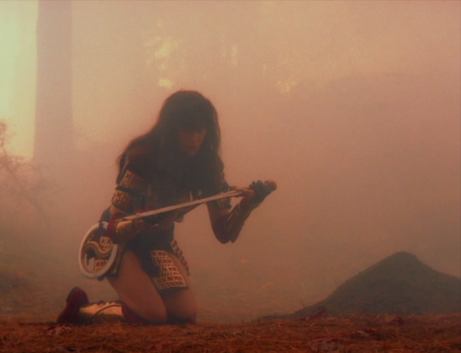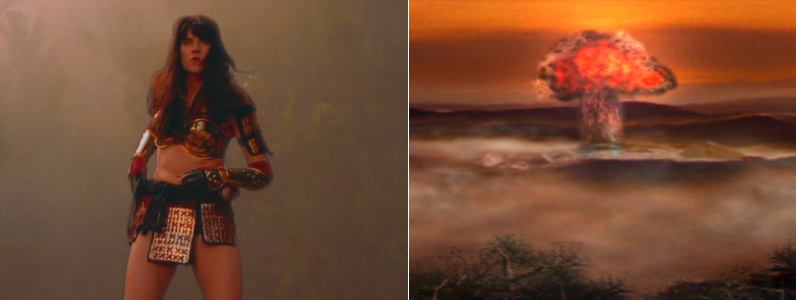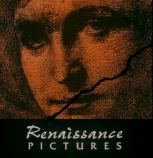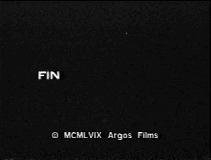The two-part series finale, A Friend in Need, brings to a close the threads discussed in this essay; however, those threads alone won't account for all the elements we'll see in this story. For that, we need to consider all the major threads involving cinema, Greek myth, Greek theater, and religion. There are a lot of creative decisions we won't be able to consider until we've had a chance to talk about those threads, but for right now, we know enough to get an idea of how it works as a final statement for Xena and Hercules.
It's been said that the episode's title sprang from the word "Fin," which is the last word seen in French movies (meaning "The end."). That's plausible, but it likely comes from Aesop's fable # 176, A Friend in Need is a Friend Indeed. The fable goes like this:
| "Two friends were travelling together when a bear suddenly appeared. One of them climbed up a tree in time and remained there hidden. The other, seeing that he would be caught in another moment, lay down on the ground and pretended to be dead. When the bear put its muzzle to him and smelt him all over, he held his breath--for it is said that a bear will not touch a corpse. After it had gone away, the other man came down from his tree and asked his friend what the bear had whispered in his ear. 'It told me,' he replied, 'not to travel with friends who do not stand by one in peril.'" |
Aesop's moral: "Genuine friends are proved by adversity."
This is a illustration of genuine friendship when it's most needed is contained in the very premise of Hercules, The Legendary Journeys, and throughout Xena, Warrior Princess. As well, confronting adversity is a defining quality of life, on Xena, and it's the defining quality of Xena's friendship with Gabrielle. It's also the defining aesthetic of Xena, Warrior Princess: the show rarely takes the path it's expected to, and its relationship with its corporate sponsors and with its audience has been to a greater or lesser extent adversarial. That's where it gets its energy from, and I think the roots of this confrontational attitude come from the producers' experience in Hollywood going all the way back to their first professional effort, Evil Dead.
The universe of Xena, which has been expanding ever since Sins of the Past, now contracts fully back to its central core. All characters that are not essential to this story are left behind; we have now arrived at the third Xena movie, which began in The Debt, and was continued in Adventures in the Sin Trade. All three movies look similar, and seem to tell the same story, at slightly different starting and end points. These are the anchors of Xena's story, and now we're finally going to see the conclusion. To tell this part of the story, we need to go to a new land and meet a new cast of characters, in order to tell the only story in Xena that needs to be told. Everything else we've seen up until now has just been a variation on a pattern.
Just like the final episode of Hercules, Full Circle, A Friend in Need also comes full circle, but it reaches all the way back to the first Hercules film written: Hercules and the Lost City. The story of a young woman, played by Renee O' Connor, who goes from offering herself as a sacrifice to a becoming a princess, is the story of Gabrielle in Xena. It's also the inverse of Xena's story, who goes from being a "princess" to offering herself in sacrifice. But in fact, Xena's and Gabrielle's story are one, if we look at it in terms of writing strategy. The series is structured to tell the story of Xena, and to do so, the character of Gabrielle is created to help illustrate her past struggle with violence, as well as to show the way to the selflessness she must adopt to achieve her redemption.
There's another important reference to Hercules and the Lost City: Xena goes to the Land of the Rising Sun, Japan. She refers to it as "Jappa," and immediately we think this is some ancient variation on "Japan," just like Ch'in is an ancient name for China. Drop a letter, and you have an ancient-sounding name. However, unlike Ch'in, there is no such ancient name for Japan, which is an English word. The Japanese never called themselves any variation of this name, though they did call themselves the "Land of the Rising Sun," since they were east of their closest neighbors, the Chinese. Where does this name Jappa come from? If we look around, we can find that name in the ancient world, but it's not in Japan: it's on the Mediterranean Sea: Joppa. Actress Lucy Lawless even pronounces it that way. Joppa is the kingdom where Andromeda was sacrificed to the sea serpent by her father, the king. This myth, according to Graves, is derived from the same roots as the Hesione myth used in Hercules and the Lost Kingdom.01 Joppa is also the city that God tells Jonah to go to, from which he boards the ship whose crew will toss him to the whale. It's a city of destiny, and an appropriate name of the land Xena will make her last stand in.
Like Jonah and Andromeda, Iphigeneia was also sacrificed at the shore to appease the gods, and we'll find Euripides' play, Iphigeneia in Tauris referenced here. Akemi, daughter of a cruel otherwordly lord, must trap souls for his consumption. She finds that one of her victims is trustworthy enough that she can ask him to carry a message to the West, calling on Xena to rescue her. This is a plot device from Euripides' play, and we'll recall that Tauris was considered the "end of the world" to the Greeks, analogous to the "Land of the Rising Sun," here. Rob Tapert has not spoken of the references used in this episode, with one exception: a Hong Kong film, A Chinese Ghost Story. It's been thought by some that this was a lazy solution for what should have been a wrapping up of the original character arcs of the series, but I disagree: Xena is not about such character arcs: all three major threads--mythic, religious and cinematic--must be addressed here, and they are. A Chinese Ghost Story is referenced in The Debt, in which Xena and Lao Ma exchange breaths underwater, and that scene is echoed here (the plot device of the messenger from Iphigeneia in Tauris is echoed here as well). Though Tapert said the story was derived from A Chinese Ghost Story, (because A Chinese Ghost Story was inspired in part from his Evil Dead film), that's not exactly the case: we actually see all three films in the Chinese Ghost Story series used here. The monk is not taken from the first movie, but rather, the third: the character in the first movie is a government clerk. The "Belly of the Whale" motif that Yodoshi represents is taken in part from the second film; and the idea of the freed souls does not actually come from any of the films. There are in fact more cinematic references used here than we're able to discuss now, and they play as important a role as A Chinese Ghost Story, but we'll discuss those later in the companion essay, "Blood on the Screen".
The original conception of Xena, in March to Freedom, is incorporated back into her story. Oi-Lan now becomes Xena once more; Oi-Lan's husband was an acrobat in her father's palace, and in the opening sequence in Jappa, we see Gabrielle, Xena's mate, drawing upon the experience she had watching acrobats to help save the burning city of Higuchi. The image we saw earlier of Oi-Lan standing in the rain is repeated here, this time with Gabrielle dressed as a Japanese warrior, demanding the head of Xena from her enemies. We'll also recall that Oi-Lan had a magic touch when it came to relieving pain, analogous to Xena's pinch. That Oi-Lan's story is used here to complete Xena's shows that it was close to Rob Tapert's vision of the warrior princess; therefore, setting the finale in Japan should not be considered a departure, but a fulfillment of the story he set out to tell. A Friend in Need is Xena in her purest form.
The killing of Yodoshi, Eater of Souls, completes the motif of the belly of the whale, which we saw in episodes like Hercules' Descent, among others. The training of Akemi to use the deadly pinch is the flip side of M'Lila's training of Xena in Destiny. We'll recall that Rob Tapert had long wanted to do a story about Xena training Medea, only to discover she trained the wrong type of person; we have something like that here, when Xena trains Akemi, and she uses it on her father to kill him, rather than to extort money from him, as Xena had planned. Akemi's subsequent request to be killed for her crime of patricide is what set Xena on the path to committing a crime so heinous that it would haunt her to the end of her days. That crime can be glimpsed in The Furies, when Xena, consumed with madness, stumbles into a village naked and accuses the women and children of killing women and children; she announces she will take her retribution "in flames." This looks like an early foreshadowing of Xena's backstory: though the specific details of the burning of Higuchi may or may not have been part of Xena's story from the beginning, I'm guessing something like it may have been, and Xena's mad accusation would be an inversion of her own crime. Of course, we learn in the finale that Xena is not aware of this crime, since it was the consequence of her drunken flamethrowing, but certainly, it may have lingered as a "morning-after" sense of dread that something horrible might have happened there--she would've sense the flames that rose as she stumbled away. This idea of an earlier injustice coming back to haunt her sounds similar to the plot device of Star Trek's The Wrath of Khan, which likely influenced the show ("Khan" was originally supposed to be a recurring villain in Xena's life). In that film, Admiral Kirk learns that he's created a vengeful monster by marooning his nemesis on a desert planet; he wasn't directly responsible for it, but through his inaction he created a day of reckoning that would lead to the death of his friend and colleague, Spock.
The plot device of the sacred katana has several sources: one is from the book, Snow Falling From Cedars. The film bears a strong resemblance in style and theme to A Friend in Need, (and is even mentioned by Xena as an inside reference); there's such a strong influence from this film, more so than from A Chinese Ghost Story, in my opinion, that I would strongly recommend it to any Xena fan who can't bear to watch the final episode, yet wishes to experience its haunting beauty. They won't be disappointed.
The other katana reference is from the Hong Kong film, Three Swordsmen, starring Brigitte Lin; at the end, she gives up the sword and the warrior way of life. The theme of succession is manifested at the end, when Gabrielle is able to wield the chakram for the first time; this recalls the final scene in Black Orpheus, when one of the children takes Orpheus's guitar and starts playing; "Now you are Orpheus," the other tells him.
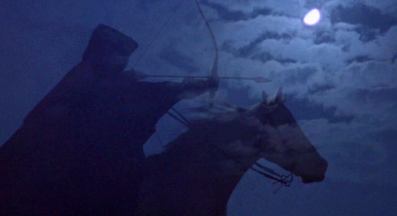
War, the first horseman of the Apocalypse, from The Rapture.
|
|
Another film reference seems to be The Rapture, starring Mimi Rogers as a woman who discovers the Apocalypse is nearing. One of the early signs is a dream of the "Pearl," by those who will be saved. She encounters a woman who has a giant tattoo on her back of the Pearl and the hand of God. Gabrielle receives a giant circular tattoo on her back of a Japanese dragon, which saves her life when Yodoshi shoots a fireball at her as she fills a bowl full of sacred water from a pool atop Mt. Fuji. The Rapture ends with the main character refusing to cross over to the other side to be with her son in Heaven because she feels God is unjust. The film probably took this plot device from a medieval poem, The Pearl, about a man who has a dream of Pearl, his love, whom he lost, is now in Heaven, and she explains what it's like to him; she also explains what will happen at the end of time. He's desperate to be with her, and attempts to cross, but wakes before he does. This poem was translated by J.R.R. Tolkien in a collection of medieval poems, so it's widely available, and would be encountered by anyone interested in Prof. Tolkien's works. It should be noted here that there was originally intended to be a third season episode called The Pearl and the Book, 02 around the time of the Rift arc, so it may play a role in that season's associations with The Pearl and the third season references in this final episode. We can even glimpse some of The Pearl's imagery at the end of The Bitter Suite, when Xena tries to unsuccessfully cross the waterfall, and Solon appears. |

